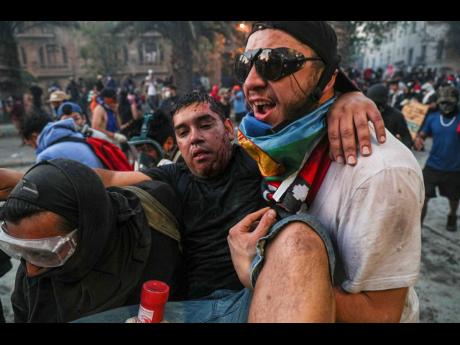Ricardo Hausmann | When markets and mobility collide
Gasolene is supposed to be combustible. But why has it also become politically explosive, as the eruption of massive protests in Ecuador and Chile suggests?
While the Ecuadorean case involved a significant increase in the price of gasolene, the revolt in Chile was triggered by a puny three per cent scheduled increase in fares on the Santiago metro.
Whether or not foreign meddling was involved, the fact remains that the protests, if not the accompanying violence and destruction, have had significant public support.
The economic case against gasolene subsidies seems ironclad. Subsidies are inefficient because they lead to consumption benefits that are worth less than what it cost society to provide them. They are environmentally harmful because gasolene consumption generates negative externalities: not only global warming, but also local pollution, congestion, and road degradation. If anything, gasolene should be taxed in order to take account of these costs. And they are deeply unfair, because the rich consume more gasolene than the poor, meaning that they get a bigger chunk of the subsidy.
But the economic case against subsidies misses other dimensions of the problem that help make sense of public opposition to meddling with transportation costs. Recognising and understanding them is crucial to devising better policy solutions.
The problem with the standard economic logic is that it neglects the role of public goods in urban life – and in mobility in particular. Streets, metros, bike paths, and highways don’t have markets or prices the way that cars and apartments do. Neither do beautiful views, public parks, and safe neighbourhoods.
Modern life requires interaction with many others, whether by working in large organisations or catering to consumers. That is why, worldwide, the share of people living in urban areas has grown from less than 35 per cent in 1960 to over 55 per cent today. In high-income countries, the share is over 80 per cent.
The possibility of interacting with others involves the capacity to move from where we dwell to where we work, shop, learn, and socialise.
How far we need to go and how much time and money it takes are determined by geographical layout and transport infrastructure. For example, Barcelona and Atlanta have similar populations, but Atlanta uses more than 26 times the area and emits more than 10 times the carbon dioxide.
Barcelona offers much better and cheaper public transport, and its higher population density boosts the network’s efficiency. Likewise, while Tokyo is more populated than Delhi or Mexico City, its commuting times are much shorter, owing to more inclusive urban planning and big infrastructure investments.
The rich choose where to live in part by considering commuting times, driving up real estate prices in those locations and pushing the poor to peripheral areas. They also drive large cars (often alone) and thus occupy more space on roads. For them, the cost of transport is not existential.
By contrast, the poor, relegated to less well-connected locations, face longer commutes – an especially sensitive concern for mothers – and must allocate more of their meagre budgets to transport.
If the mobility infrastructure is lousy, commuting to the central business district to take advantage of better job opportunities may be so onerous that people remain trapped in less-productive informal activities closer to their low-income neighbourhoods. This constitutes a poverty trap: because you are poor, you cannot get to the good jobs, which means you will remain poor.
In such a context, using market prices to balance transportation supply and demand would systematically exclude the poor from the benefits of urban life. Those with less income – say, students from poor families trying to get to school – would be the ones to stop travelling when prices rise. That is why many metro systems, including Santiago’s, have special prices for students. Just as we do not use auctions to allocate transplant organs, non-market principles are needed to manage transportation.
The same is true of other valuable urban amenities. Compared to suburbanites, city dwellers tend to spend less time in their smaller apartments and more time in shared public spaces. But New York’s Central Park, London’s Hyde Park, or Paris’s Bois de Boulogne, which are available free of charge to all, would soon become country clubs or gated communities if they were turned over to the market.
Because the bulk of transportation costs are fixed, in the sense that they are incurred at the time of construction, cities have many degrees of freedom to decide who pays for them and when. Consider a metro system: how much of the cost should be paid by future generations, the young, the elderly, and the working-age population? How much should be paid by the system’s users, and how much by those who benefit from lower congestion on surface roads or from real estate prices buoyed by proximity to a station?
More fundamentally, how much of the allocation of space should be left to markets, where every dollar is the same, and how much to a mechanism that treats every citizen the same? As Harvard’s Michael Sandel has put it: “The more things money can buy, the harder it is to be poor.” If access to safe neighbourhoods, good jobs, and public spaces is limited by lack of money, the poor will tend to find market allocation unfair.
None of this justifies gasoline subsidies. Quite the contrary. These resources are much more efficiently and fairly used to ensure that everybody has access to the opportunities and pleasures of social life. But what people expect, and what governments should provide, are policies that improve the quality of shared public space and the efficiency and affordability of the means to navigate it.
Ricardo Hausmann, a former minister of planning of Venezuela and former chief economist at the Inter-American Development Bank, is a professor at the Harvard Kennedy School and director of the Harvard Growth Lab.
Copyright: Project Syndicate, 2019
www.project-syndicate.org



